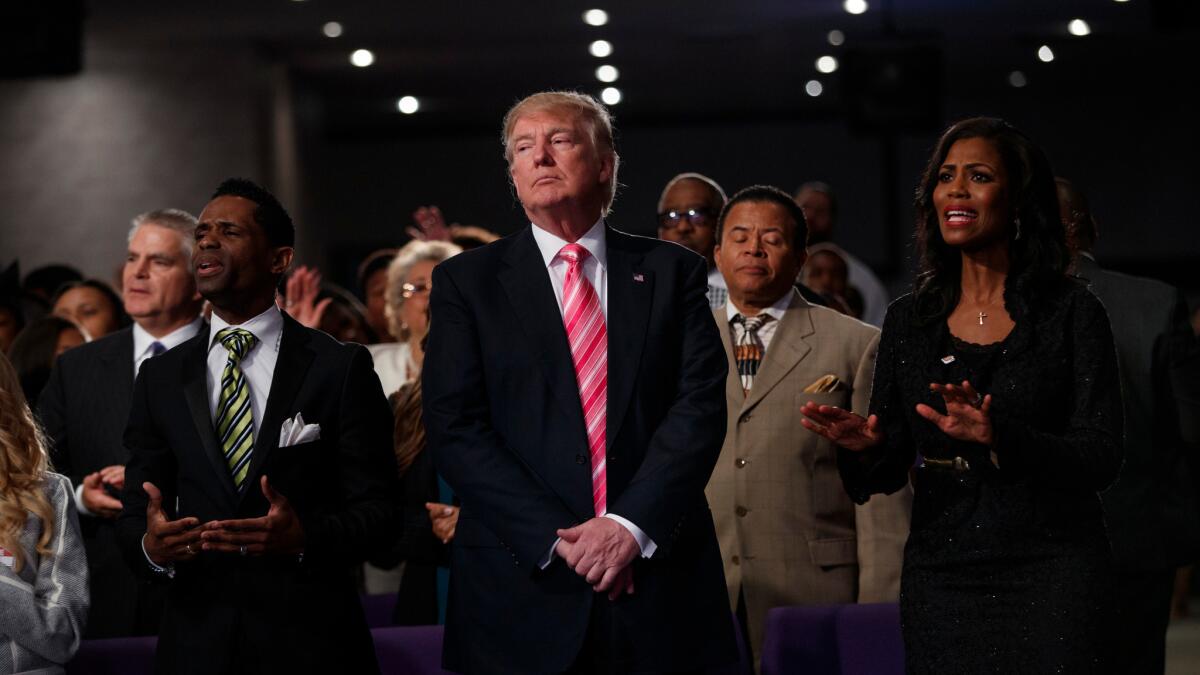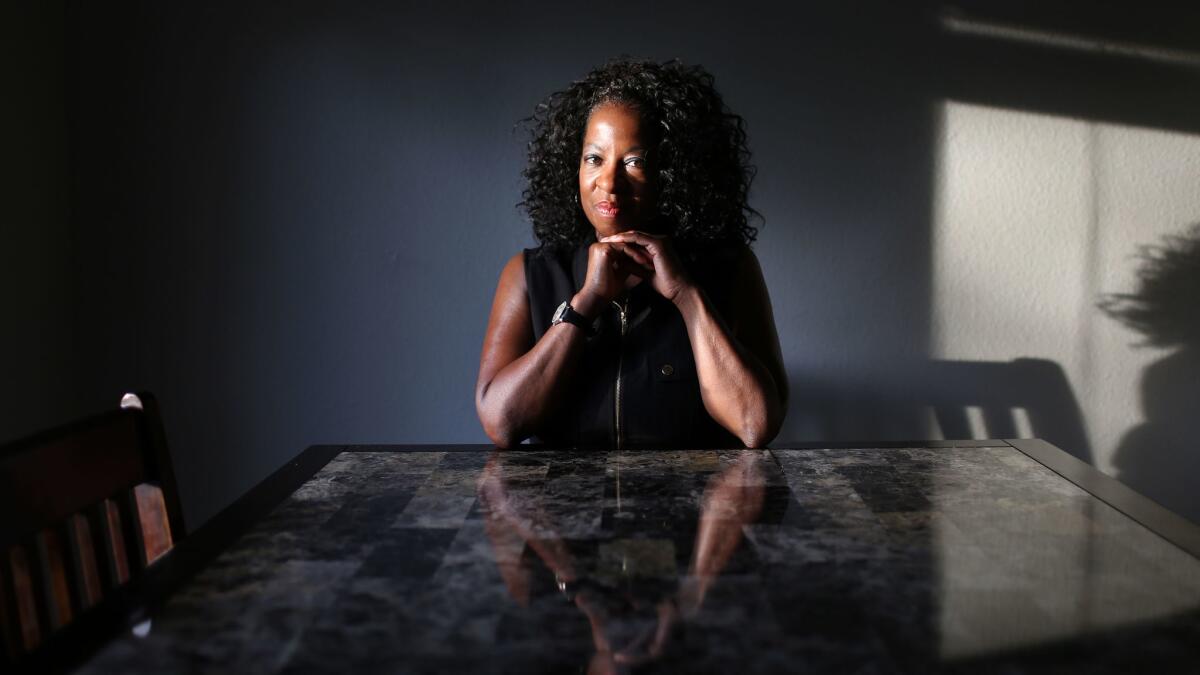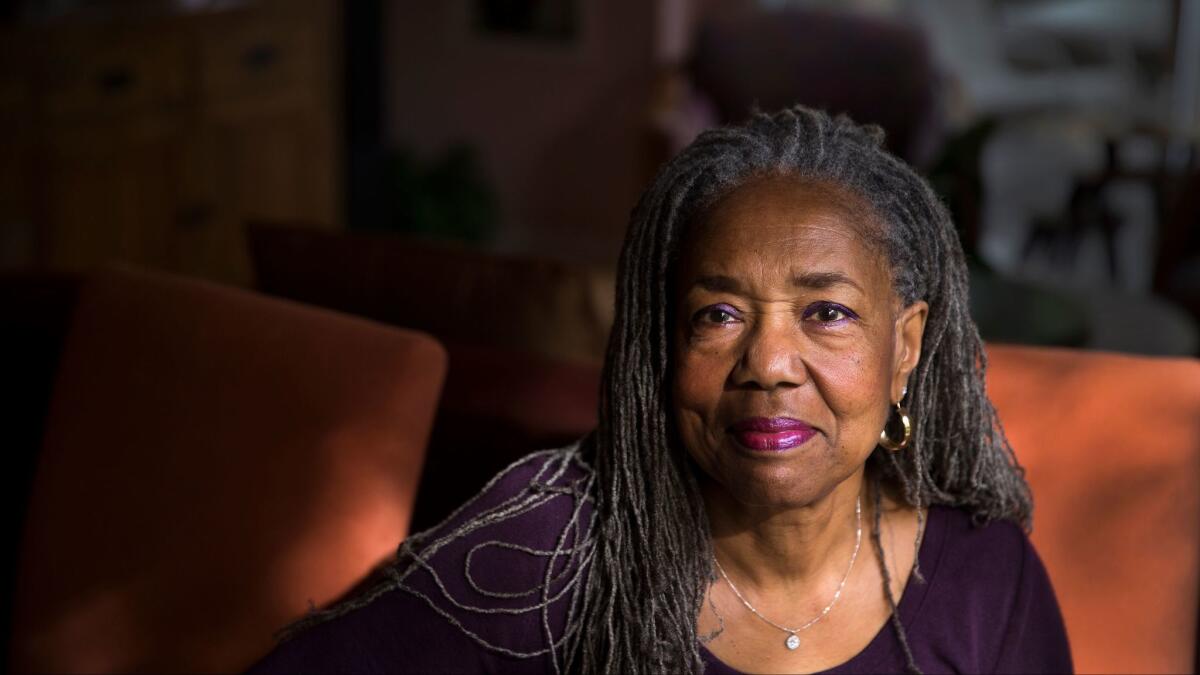Trump says African-Americans are living in hell; here’s what African-Americans are saying

Donald Trump looked out at the crowd of supporters at a rally in Ohio last month and ticked off the troubles he said plague black America: “The violence. The death. The lack of education. No jobs.”
This, he said pointing in the imagined direction of an inner-city “ghetto,” is a place where “you buy a loaf of bread and end up getting shot.” Essentially, he said, African-Americans are “living in hell.”
But what exactly does that mean?
“To say African-Americans are living in hell, that has the descriptive specificity of a bumper sticker,” said Cornell Brooks, president of the National Association for the Advancement of Colored People. “There are communities where there are hellish conditions, but there are also communities where you find people who are gainfully employed, who attend houses of faith. There are vibrant cultural and artistic communities.”
Black Americans have reached the highest of highs — a black man as president — yet still account for a disproportionate number of people in prison. The majority of America’s more than 37 million black Americans aren’t poor, and reside not in inner cities, but in suburbs. Yet more than a quarter live in poverty, a rate second only to that of Native Americans.
It’s undeniable that in recent years African-Americans have made substantial gains. Their employment numbers grew in 2015, hitting their highest marks since before the Recession. Poverty levels are dropping; life expectancy is increasing.
Still, the 8.3 percent unemployment rate for African-Americans is nearly twice that of whites.
Gaps between African-Americans and other racial groups in education are gradually closing, and black spending power stands at $1 trillion to $1.5 trillion, according to the National Urban League.
Yet life-threatening chronic health challenges remain. The leading causes of death for African-Americans are heart disease, cancer and stroke, according to the Centers for Disease Control and Prevention. Diabetes and obesity remain stubborn problems, as do maternal and infant health.
But even those black Americans who face the highest hurdles are surprisingly optimistic, polls show. According to the Gallup-Healthways Well-Being Index, poor blacks were the most likely to believe they would have a brighter future than any racial group — and more likely than Americans as a whole.
Sociologists credit that to a strong sense of family and community, while civil rights leaders also point to the vast improvements in quality of life for individuals when the bigger picture is taken into account.
“If you look at the progress we’ve made since the 1960s, there’s been substantial progress in many areas,” said Marc Morial, president of the National Urban League. “But … the condition of blacks vis-à-vis whites has not dramatically changed over the last 40 years. The old analogy is the caboose analogy: African-Americans are like a caboose on a train. When the train speeds up, the condition of African-Americans will speed up too. But the caboose is still the last car on the train.”
Here’s the outlook in 2016:
African-American households are more than twice as likely to lack an adequate supply of affordable and nutritious food
Lanarion Norwood, 18, Atlanta
Lanarion Norwood grew up rationing food.
“We were on food stamps, and eating was something you had to plan accordingly,” says the Atlanta native, who was raised on his grandmother’s disability income because his mother was still in her mid-teens and lived at home.
“When you’re getting government assistance, you have to eat and make the food last. When you’re on food stamps, you have to buy lower-quality food because lower-quality food is cheaper and you can get higher quantity. You have to buy processed food.”
Norwood never ate three square meals a day. His typical diet consisted of ramen noodles, canned pork and beans and hot dogs. He never realized he was suffering from malnutrition. But the signs were there.
“I noticed that when I wasn’t eating right, my mental and physical performance and my school performance wasn’t the best,” he said. “When you have little money, you have to decide whether you’re going to pay for food or for the light bill.… You think, I can either not eat and go hungry or not pay the heating bill and go cold.”
The lack of money and proper nourishment did not prevent Norwood from graduating high school and landing a scholarship to attend Atlanta’s prestigious historically black Morehouse College, where he is a freshman studying political science.
Compared with how he grew up, the college cafeteria seems bountiful. His favorite: Baked — not fried — chicken, collard greens, macaroni and cheese and peach cobbler.
“I feel more focused and determined now than ever,” said Norwood, who is the first in his family to go to college.
“I wouldn’t call it hell, but it is a struggle and the struggle is real…. not just for black people but also for underprivileged people.”
Heart disease, obesity and diabetes remain chronic problems for African-Americans

Tyra Bryant, 49, Lancaster, Calif.
Tyra Bryant’s wake-up call came a year and half ago, when her doctor told her she was fat.
“He told me I was obese and I would be on all kinds of medication if I didn’t turn my health around,” recalled Bryant, 49, who carried 235 pounds on her 5-feet, 2-inch frame. She was pre-diabetic, had high blood pressure and suffered from headaches, stomach problems and depression.
“I walked out of that office and I just said I’ve got to make a change,” said the mother of four, who works as a licensed vocational nurse at Tehachapi State Prison. “I didn’t want to be sick. I saw my husband being sick. I didn’t want to go that route.”
Her husband died on Thanksgiving morning 2014. He had suffered from high blood pressure, diabetes and kidney disease. Two of Bryant’s children have mental illness.
She largely blamed her excess weight and her husband’s ailments on the family’s eating habits: hamburgers, French fries, chicken wings, ice cream, soda — convenient and cheap. She could often feed the family for under $20.
“There are no health food restaurants in our community …only fast food restaurants,” said Bryant, who lives in a predominantly African-American community on the east side of Lancaster.
“Unemployment is really high among blacks in the community, so families look for the cheapest option. I think that’s what killing our community,” she said.
Determined to change, Bryant began controlling portions. She cut out fried and salty foods and sugary snacks, and started exercising three to four times a week. She lost 90 pounds and is no longer pre-diabetic. She bid farewell to her blood pressure medication.
“Once I started exercising and eating healthy, my whole mindset changed,” said Bryant. “I got happy. I started feeling good.”
But that good feeling only spreads so far.
“I feel happy as an African-American woman,” she said. “I feel fulfilled in my life right now. But I do feel at times that I’m blocked from reaching my dreams because [they’re] not really available or accessible to me, especially in the community I live in.”
“In a perfect world … I would host a health food talk show and I would teach people to live their best, healthy life … and watch them literally change their lives living healthy,” she said. “Had I been a different race — and I’m not racist or anything — I think I would be taken more seriously.”
“It is hard being a black American woman,” Bryant said.
African-Americans are often the target of police violence

Jeremiah Thomas, 22, Milwaukee
When a black man died after being shot by a police officer during a foot chase in a poor black neighborhood in northern Milwaukee, rioters smashed police cars and set a gas station and beauty store on fire. The National Guard was put on notice and police in armored trucks circled the neighborhood. As protesters hurled rocks at officers and dodged tear gas, Jeremiah Thomas followed the marches with another purpose.
“I wanted to find the good in our city, and help the people who want to uplift the community and solve our issues,” said Thomas. He documented protests with his iPhone to share with civil rights advocates on social media, and later joined members of a group called Operation Save Milwaukee to mentor young kids who were distraught by the tense days of street protests and violence.
“You know, Milwaukee is a hard place. It’s hard to make it out. You’re often either in prison or you’re in the grave. But it’s our home, and there are good people here,” said Thomas, 22.
He knows the challenges well. Cocaine took a toll on several family members, and at 16 he was kicked out of the house during a snowstorm.
He had to support himself through high school, eventually graduating and enrolling at the University of Wisconsin-Milwaukee, where he now studies biochemistry. He drives to Chicago every few months to take part in mixed martial arts fights, and mentors kids with autism. An aspiring actor, he also just did his first film.
It’s called “53206.” The numbers are a reminder of where he came from — and how far he’s come.
The ZIP Code is among the most violent in the country, in one of the nation’s most segregated cities, where wealth flows among whiter southern and eastern neighborhoods while poorer black neighborhoods in the north are more likely to struggle.
In the small-budget movie that’s set to release next year, Thomas plays a drug dealer who is trying to find a better life yet is caught up a cycle of crime.
“Struggles in the city are real,” said Thomas, who now lives on his own in Wauwatosa, a city just east of Milwaukee. “But it bothers me when people point to us as this horrible place.”
“Yeah, a lot of bad is happening. But we find it funny when liberals and politicians try to come in and say they can fix things. They just drop in and use us as a backdrop and then they go,” Thomas said. “They don’t see the organizations helping the community, the kids who are succeeding despite all the challenge.”
There are proportionally more black Americans in prison, and they stay there longer
Kunta Kenyatta, 48, Canton, Ohio
When people meet Kunta Kenyatta, they usually see him in his light-gray coveralls, peering out from the driver’s-side window of his white truck, with “Kunta’s” printed on the door. In this small city of 72,000 about 80 minutes south of Cleveland, he runs one of the go-to car towing services.
During tows, he occasionally gets questions about how long he’s been in the business. Not too long, he explains, saying his first full-time job was at an auto-detailing shop in 2003, the year after he got out of prison.
“They’re surprised,” said Kenyatta. “Prison? Really?”
Kenyatta is 48. Much of his adult life — 16 years, until he was paroled at 34 — has been spent in prison, where he served time for robbery and attempted murder.
Now, between the 12-hour days he spends with the towing company he runs with his wife and managing two rental properties in Cleveland and Canton, he travels the country speaking about prisoners’ rights. Kenyatta, who is part of the Industrial Workers of the World’s Incarcerated Workers Organizing Committee, wrote about his prison years in a book, “Life After Life: A Successful Return to Society.”
“It’s not a lot of prisoners who make it. Unless you know somebody who’s been incarcerated — and every black person does — it’s hard for people believe what goes on in prisons. It’s getting harder on the inside, and on the outside when you get out,” said Kenyatta.
Back when he got his first job in 2002 cleaning cars at the Cleveland shop, employers were more lenient on former prisoners, he said. His job application asked if he had been convicted of a felony in the last seven years, and he could answer “no.”
“A lot of states are banning that box that asks you about convictions now, but other ones now ask you if you have ever been convicted of a felony — period. And at the same time, jails have grown and education has gone down. I almost got my associate’s degree using Pell Grants,” Kenyatta said. The federal grants were banned for most prisoners beginning in 1994.
After his release, Kenyatta lived with his mother. He scraped by, saving to buy his first tow truck for $20,000 in 2007. He attracted customers by offering discount prices. He scored deals via auctions on the six rental units he owns in Cleveland and Akron. He married his girlfriend, now the towing operations manager, in 2008.
“‘I got lucky,” said Kenyatta, who hopes to retire when he’s 50. “It takes a lot of work, focus and sacrifice to make it out and be OK.”
Low-income minority communities are disproportionately exposed to pollution and hazardous waste
Julia Lucy, 43, Eight Mile, Ala.
“We do live in hell,” says Julia Lucy, a resident of this largely low-income African-American community. “We are sometimes in hopeless situations.”
Lucy’s hell stems from the nauseating, rotten-egg stench of mercaptan, a chemical that is added to natural gas to give it its distinctive order. The chemical leaked into the soil and groundwater in Eight Mile for months after a storage tank was hit by lightning eight years ago.
Eight Mile residents suffer a long checklist of maladies that residents blame on the mercaptan — headaches, nausea, unexplained rashes, hypertension.
Lucy views the situation as a microcosm for what’s happening to low-income African-Americans across the country.
“I think some of it is money. I think some of it has to do with race,” she said. “If this had happened in an affluent white community they would not have had to suffer for this length of time, and someone would have come in to assist them.”
What’s unfolded in Eight Mile has driven Lucy toward political activism. A student support services coordinator at nearby University of Mobile, her alma mater, Lucy is now on the board of the We Matter 8 Mile Community Assn., an environmental justice group pushing for reform.
“I want our residents and citizens to become knowledgeable of what a wholesome, sustainable environment is, what their rights are,” she said.
The contamination has left Eight Mile residents financially vulnerable.
Lucy and her husband poured their life savings into building their home in 2004 — a four-bedroom brick ranch home on a large corner lot where they had expected to live out their lives.
“We’ve thought about leaving, but I can’t sell my home,” Lucy said. “And I can’t just abandon it. How do we get out of here? No one will come to help us.”
High school graduation rates are up, but only 22.5% of blacks older than 25 have a college degree, compared with 36.2% for whites

Mary Watson-Bruce, 70, Irvine
When she looks at her grandchildren, Mary Watson-Bruce is in awe of how different their world is from the one she grew up in, in the 1950s and 1960s.
When she met her future husband as a student at the University of Texas at Austin, she was legally barred from marrying him because he was white. They wed three years later in 1967, the same year the Supreme Court ruled against interracial marriage bans.
She thinks of how she grew up in segregated Houston, where her college-educated parents instilled in her the lesson that college wasn’t a just a path to better jobs but a way to protect her body.
“If you weren’t an educated woman, you’d work as a servant for white people and you’d get molested in their homes,” Watson-Bruce said. “It was a way to get opportunity and protection.”
She went on to earn a doctorate in gerontology after moving to Southern California with her husband, a history professor. Before retiring eight years ago, she had served as associate director of geriatric medicine at UC Irvine, had opened several health clinics for poor Southern Californians, and was a consultant for senior living centers.
“I came to adulthood on the cusp of receiving all the benefits of the civil rights movement. Things that were closed to black people were now opening up to them,” said Watson-Bruce. “And I took advantage of that.”
Since retiring, and especially since her husband’s death two years ago, Watson-Bruce has spent her time volunteering for local nonprofits that focus on housing and the elderly; and has donated thousands to help establish the National Museum of African American History and Culture in Washington, D.C., attending the opening in September.
She’s kept herself busy traveling to dozens of countries — Senegal, Cambodia and Cuba are among the highlights — and is considering a trip to Paris this year. She spends her weekdays in yoga classes and hiking by the Pacific Ocean.
For her generation, things aren’t perfect now, but they’re vastly improved, Watson-Bruce said.
“Don’t even think life was good for blacks in the 1950s. Don’t ever think that. There was segregation, lynching; there were large communities that were out to kill and maim black people. Black people had no voice in the courts,” she said.
“Our lives are so much better now. We have the ability to become president. We’re able to speak up and make America keep its promise to black people. We’re having a conversation now, and people are listening to Black Lives Matter, talking about police and shootings.”
One of Watson-Bruce’s most vivid memories is the death of Martin Luther King, Jr. She even remembers the dress she was wearing.
“It was green and yellow with a bow in the back, three-quarter sleeves, a square neckline. A mini-skirt,” said Watson-Bruce. She was 21.
“It felt so strange. MLK was the one who was protecting us,” she said. “You can still feel his impact today.”
More to Read
Start your day right
Sign up for Essential California for news, features and recommendations from the L.A. Times and beyond in your inbox six days a week.
You may occasionally receive promotional content from the Los Angeles Times.








